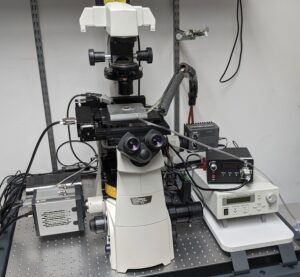 Physics researchers are using a microscope-mounted cold stage to study the crystallization of ice, as well as ice structuring proteins that inhibit it. The microscope holds a temperature-controlled sample and is 10 times more powerful than the industry standard.
Physics researchers are using a microscope-mounted cold stage to study the crystallization of ice, as well as ice structuring proteins that inhibit it. The microscope holds a temperature-controlled sample and is 10 times more powerful than the industry standard.Katz School researchers are developing an advanced method for examining how ice crystallizes and how antifreeze proteins inhibit the crystallization process.
Dr. Ran Drori, assistant professor of chemistry in YU’s Stern College for Women and the Katz School’s M.A. in Physics, is studying the unique ability of ice-binding proteins, or antifreeze proteins, to both accelerate and inhibit the growth of ice using a microscope-mounted cold stage, which holds a temperature-controlled sample and is 10 times more powerful than the industry standard.
In August, Dr. Drori and Katz School graduate student Yitzhar Shalom published their findings in the paper, “A Microfluidic Approach for the Study of Ice and Clathrate Hydrate Crystallization,” in the Journal of Visualized Experiments.
The researchers manipulated the fluids surrounding ice crystals in a temperature-controlled environment that prevented the crystals, which are 10 times smaller than the width of a human hair, from growing.
“We developed this method of growing tiny crystals under a microscope and added the unique ability of replacing the solution around them to discover new ways by which antifreeze proteins inhibit these crystals,” said Dr. Drori.
Antifreeze proteins bind to the surface of ice crystals, stopping the growth of ice. For example, there’s an ingredient called an “ice structuring protein” that is added to ice cream to keep the tiny ice crystals small and prevent freezer burn, or the formation of large ice layers that change the texture of the ice cream.
But where do these proteins come from and how do they stop ice growth? Fish, plants and insects endogenous to cold environments rely on antifreeze proteins for survival and the prevention of injuries. (The food industry understandably renamed them “ice structuring proteins,” since, presumably, no one would eat ice cream with antifreeze in it.)
These organisms contain tiny ice crystals in their bodily fluids that must remain small to prevent injury. The antifreeze proteins bind to the ice surface and coat the ice crystals to suspend their growth.
The study of water crystallization has wide implications. For example, companies drilling for natural gas encounter gas hydrate formation—a crystalline material composed of water and methane gas—in the wells that are submerged deep in the ocean floor.
“Our method provides unparalleled possibilities to examine the crystallization process and binding mechanisms of the inhibitors,” said Dr. Drori. Michael Bettencourt in YU's Institutional Advancement office contributed to this story.
